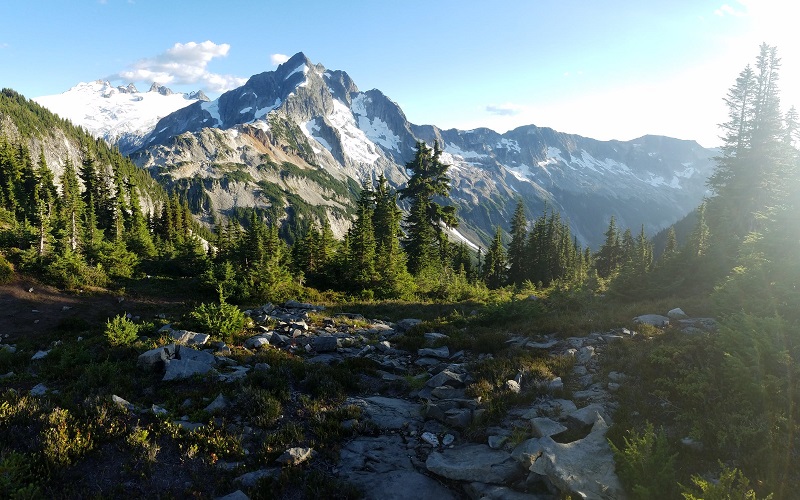via Jeff L. Howe: Until the 1970’s, one of the great, burning questions of geology remained unanswered. In light of 20-20 hindsight, it may seem trivial, trite, or unworthy of true scholarlY consideration – a mere exercise in mental gymnastics simply for the sake of mental gymnastics. Yet it occupied the collective minds of science for thousands of years like a great,aching, sore thumb until it was solved:
Where do mountains come from?
That mountains existed was never in question. You can see them, you can touch them, you can climb them. Mountains just… are. They effect the weather and they define our borders. They provide backdrops for paintings and photographs and form barriers to transportation. They’re as old as the hills. Not only do they exist, but there is an enormous body of geologic evidence to indicate that successive, multiple generations of mountains have come and gone in Earth history, leaving little behind but the remnants of tortured cores, miles of sandy beaches and thousands of vertical feet of outwash plains from which future mountain ranges will beformed. All mountains ultimately flow to the sea. But where do they
come from?
Consider this: all around you, everything is falling down. Rain falls to the ground and runs in ever-gathering rivulets. Rocks at the tops of mountains crack and break and then tumble down the cliff where mountain streams gobble them up and tumble them into sand. A knife accidentally brushed from the table drops to the floor. Dust settles on a little used shelf. Apples drop from trees and snow falls from the sky. Airplanes always land. Everything, it seems, is falling down.
With the possible temporary exception of volcanoes and cumulus clouds everything is falling down. Nothing is falling up! It’s as if the entire planet is slowly settling, melting like a tab of butter left on a warm stove. And once everything has finally fallen down, everything will BE down and the Earth should be as round and as smooth as a billiard ball. In fact, if the planet is as old as geology says it is – 4.6 billion years – the entire world should be as flat as a parking lot. There should be no topography, no elevation, no mountains. But there are.
What are we missing here?
Awareness of the problem had its origins in prehistory when ancient peoples attempted to counteract this downward falling by building enormous structures that defied gravity: pyramids, statues, obelisks and temples. They were avenues to the gods, to immortality, a hedge against falling down. All but a few have fallen, some have gone completely to the sea. Those that remain continue to fall slowly.
In the 16th century, the great era of global exploration produced world maps of increasing quality and reliability. People immediately began to notice and speculate on the uncanny jigsaw puzzle-like fit of the continents. As explorers fanned out over the newly discovered lands they discovered fossils and rock types and even signs of ancient glaciers that seemed to bind the continents together over the oceans. It appeared that the Earth, for all of its timeless stability, was in motion. But no feasible mechanism could be envisioned. Continents can’t plow through the oceans like ice breakers. Yet they did. And where the evidence of motion was the most chaotic, mountain ranges seemed to result.
Early geology was not short on theories, but most involved isostasy – the buoyant effect of things seeking their own density. Mountains eroded, they reasoned, with rivers delivering their sediment to the ocean floor at the mouths of major rivers. This layer of sediment piled deeper and deeper beneath the water until it could take it no more, and then rose to the surface like a bobber freed from the weeds. Voila! A mountain range was formed. This mind-boggling process even had mind-boggling words like eugeosyncline and miogeosyncline to describe the resulting structures.
It took Big Science of the 20th century to finally put it together and call it plate tectonics. The seemingly stable surface of the Earth is actually composed of delicate fragments (“plates”) that resemble the fractured shell of a blue Easter egg carelessly dropped to the floor. Mountains originate in the radioactive decay of elements born billions of years agoin the detonations of ancient supernovae. Driven to the core of the planet by density and gravity, the resulting gravitational crush of energy reemerges as plumes of heat rising through the surrounding mantle. The searing heat rises slowly upwards from the center until it reaches the relative cold and immobility of the underside of the broken crustal shell.
There it spreads out laterally, dragging the plates. With it, slamming and ripping them, jostling and elbowing them like great sheets of cracking ice on a moving river.
When the crustal plates slide past one another, their worn and uneven surfaces grab and let go like an inch worm, storing and releasing tension. This tension can be released very gently or with intense fury. The gentle release is like a cat stretching in the sun. It is subtle, cathartic, barely felt. It is measured in slippage between sand grains, microscopic cracks in the rock and the slow folding of rock layers. The fury is less subtle, manifesting itself violently as earthquakes and their resulting marine counterparts – the giant tsunami.
When the plates pull apart, molten magma rises to seal the cracks creating ocean basins and new crust. Like a scab that never heals, the oceans open, ooze by bloody ooze. But when crust is created, crust elsewhere must be destroyed. When the crustal plates converge and collide, they do so with a grinding, contorting, upheaving violence – a violence that occurs in geologic time like the head-on collision of two speeding trucks, but which to humans takes place barely at the rate of growing fingernails. The resulting deformed welt can raise the ground tens of thousands of feet into the air: the Himalayas, the Alps, the Andes, the ancient Appalachians. And then, unimpeded, the rock resumes its slow, inexorable march to the sea.
The planet inhales. The planet exhales. What falls up, must eventually fall down. And what falls down, falls up again.
That’s where mountains come from.







